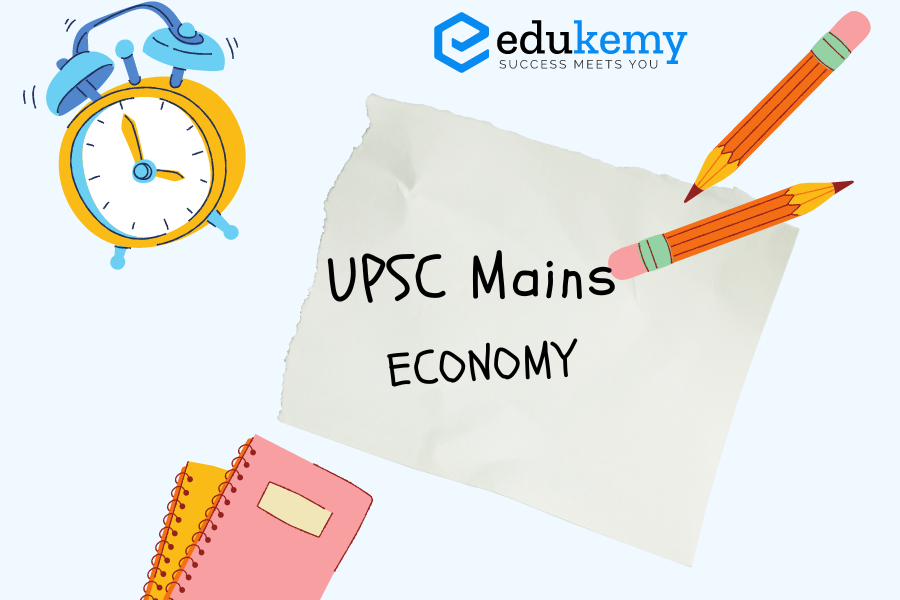
Introduction:
A circular economy, aiming to maximize resource efficiency and minimize waste and environmental impact, presents an innovative model in contrast to the traditional “take-make-dispose” pattern. India, grappling with resource scarcity and environmental degradation due to rapid industrialization and population growth, requires innovative approaches to address these pressing challenges.
Body:
Resource Scarcity and Environmental Degradation in India:
- Water Scarcity: Uneven distribution and over-extraction lead to depleted aquifers, causing water stress, and affecting crops and drinking water.
- Air Pollution: Vehicular emissions, industrial pollution, and crop burning contribute to hazardous air quality, impacting public health.
- Soil Degradation: Soil erosion reduces agricultural productivity, evident in the declining fertility of the Indo-Gangetic plain.
- Biodiversity Loss: Deforestation, habitat destruction, and poaching threaten India’s rich biodiversity.
- Waste Management: Improper disposal practices and limited recycling facilities contribute to environmental pollution.
- Depletion of Non-Renewable Resources: High coal consumption and mineral extraction raise concerns about resource depletion and land degradation.
- Climate Change Impacts: Extreme weather events disrupt agriculture and livelihoods.
Extent of Transition to a Circular Economy:
- Policy Initiatives: Government programs such as “Make in India,” “Swachh Bharat Abhiyan,” and the National Mission for Sustainable Agriculture drive the circular economy transition.
- Industrial Shift: Sectors like textiles, electronics, and automotive are increasingly adopting sustainability and circular practices.
- Waste Management: Innovations like waste-to-energy plants and improved waste segregation enhance circularity in waste management.
- Consumer Awareness: Growing public awareness promotes waste reduction and recycling through social enterprises and startups.
Readiness of Indian Industries and Businesses:
- Technology Adoption: Industries are gradually adopting technology for product life extension and recycling.
- Investment in Innovation: Businesses invest in research for sustainable and recyclable products.
- Collaborative Efforts: Collaboration with waste management companies creates closed-loop systems, notably in plastics and packaging.
- SME Participation: Small and medium-sized enterprises actively engage in circular practices, such as textile recycling units.
Challenges to a Circular Economy in India:
- Technological Constraints: Limited access to advanced recycling technologies hampers adoption, especially in rural areas.
- Economic Considerations: Circular practices may be perceived as costly, hindering adoption, particularly for small and medium-sized businesses.
- Inadequate Infrastructure: Efficient waste management infrastructure is lacking in many regions.
- Policy and Regulatory Issues: Lack of strict enforcement and consistent regulations hinder effective policy implementation.
- Behavioral Resistance: Shifting consumer behavior from linear to circular models is challenging and often met with resistance.
- Resource Availability: The limited availability of recycled materials poses challenges for industries.
- Lack of Circular Business Models: Many businesses are unfamiliar with circular models, impeding the transition.
Existing Policies and Initiatives:
- Make in India: Aims to boost domestic manufacturing, encouraging sustainable materials and resource-efficient practices.
- Swachh Bharat Abhiyan (Clean India Mission): Focuses on cleanliness and waste management, leading to improved waste segregation and waste-to-energy plants.
- National Mission for Sustainable Agriculture: Promotes sustainable farming practices, reducing the environmental impact of agriculture.
- E-Waste Management Rules (2016): Regulates the management and recycling of electronic waste, ensuring responsible disposal.
- Plastic Waste Management Rules (2016): Focuses on reducing single-use plastics and enhancing plastic waste recycling.
Conclusion:
India holds the potential for a successful transition to a circular economy. Robust policies and initiatives, coupled with proactive measures, can address resource scarcity and environmental degradation, ensuring a sustainable and eco-friendly future for the nation.

In case you still have your doubts, contact us on 9811333901.
For UPSC Prelims Resources, Click here
For Daily Updates and Study Material:
Join our Telegram Channel – Edukemy for IAS
- 1. Learn through Videos – here
- 2. Be Exam Ready by Practicing Daily MCQs – here
- 3. Daily Newsletter – Get all your Current Affairs Covered – here
- 4. Mains Answer Writing Practice – here

